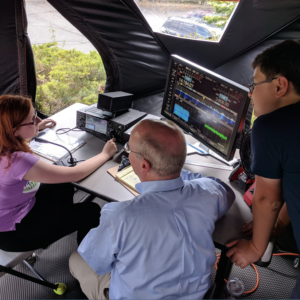Description
This course is not currently available, but we hope to offer it again soon.
Let’s Build Ourselves an Antenna
This project teaches you how to build and tune a UHF (70cm), 1/4 wave vertical antenna with ground plane using simple, off-the-shelf materials and a nanoVNA.
The project will have two goals:
1) To teach the practical use of the nanoVNA to make measurements on RF components and systems, with an emphasis on antenna measurements, and
2) To have each participant build, tune, and test a (hopefully) weather-proof ground-plane antenna suitable for base-station use at home, or for portable use in outdoor ham activities.
You will need antenna hardware

For the antenna construction you will be provided with instructions and all the hardware. You will assemble the antenna, and use the NanoVNA to tune it to resonance in the 70cm band, and examine the effect of the number and angle of the radials. We plan to have a set-up ready for you to compare the performance of your new antenna with the “rubber ducky” on your HT.
The cost of the activity will be minimal, just enough to cover the hardware. Here are your hardware options:
Purchase includes the following: Pre-drilled PVC cap and 3/4″ pipe adapter, SO-239 connector, 12 AWG wire, mounting base, and bolts/nuts. When you get home, you can use the antenna any way you want, as built for indoor use, or for mounting outdoors. You are on your own to supply a length of coax that will reach from antenna to radio for your applications. Or, you are welcome to purchase some 3′ or 6′ lengths of assembled cable from us.
You will need a NanoVNA
Participants should purchase their own nanoVNA (cost ~$60 to $90) and bring it to the session. Recommended choices on Amazon:
NanoVNA-H (2.8″ screen) ($60) CLICK HERE
NanoVNA-H4 (4″ screen) ($99) CLICK HERE
Beyond that no experience with a VNA will be expected. We will instruct you on how it works, how to calibrate it, and the use of the (free) VNAsaver software package. If you have a lap-top, please bring it. We will have exercises in making measurements on simple components, filters, and antennas.
If you want to take part, but don’t want to purchase a nanoVNA at this point, we hope to have have 2-3 loaners available, or perhaps you might team-up and share with a friend who owns one.


